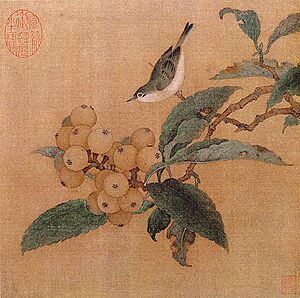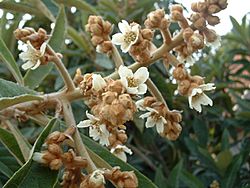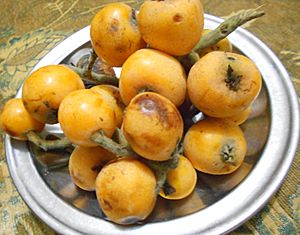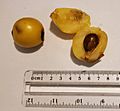Loquat facts for kids
Quick facts for kids LoquatEriobotrya japonica |
|
|---|---|
 |
|
| Loquat leaves and fruits. | |
| Scientific classification | |
| Kingdom: | |
| (unranked): | |
| (unranked): | |
| (unranked): | |
| Order: | |
| Family: | |
| Genus: |
Eriobotrya
|
| Species: |
E. japonica
|
| Binomial name | |
| Eriobotrya japonica |
|
| Synonyms | |
|
Mespilus japonica |
|
A loquat is a tropical fruit that grows on a tree. Since it needs warmth and moisture, it grows best in a warm, wet climate.
Loquats are usually yellow or orange. They have large brown seeds inside. People can eat the skin or peel the fruit before eating it.
Contents
About the Loquat Tree
The Eriobotrya japonica is a large evergreen shrub or a small tree. It has a round shape, a short trunk, and fuzzy new branches. This tree can grow to be about 5 to 10 meters (16 to 33 feet) tall. But often, it is smaller, around 3 to 4 meters (10 to 13 feet).
The fruit starts to get ripe in spring or summer. This depends on how warm the area is. The leaves are arranged in a special way. They are simple, about 10 to 25 cm (4 to 10 inches) long, and dark green. They feel tough and leathery. Their edges are like tiny saws. The underside of the leaves is very fuzzy with thick, yellow-brown hairs. Young leaves are also fuzzy on top, but this fuzz soon wears off.
Loquat Fruit and Flowers
Loquats are special because their flowers appear in autumn or early winter. This means the fruits are ready to eat from early spring to early summer. The flowers are about 2 cm (0.8 inches) wide and white. They have five petals. They grow in groups of three to ten flowers. These flowers have a sweet, strong smell that you can notice from far away.
Loquat fruits grow in bunches. They can be oval, round, or pear-shaped. They are about 3 to 5 cm (1.2 to 2 inches) long. Their skin can be smooth or slightly fuzzy. It is usually yellow or orange, sometimes with a red blush. The juicy, tangy inside of the fruit can be white, yellow, or orange. It tastes sweet to slightly sour, depending on the type of loquat.
Each fruit has one to ten seeds inside. Usually, there are three to five seeds. These seeds are large and brown. The skin is thin and can be peeled off easily when the fruit is ripe. In Egypt, people often grow types of loquats that are sweeter and have fewer seeds.
The fruits taste best when they are soft and orange. Their flavor is a mix of peach, citrus, and a mild mango taste.
Loquat History

The loquat first came from China. In China, it is called pipa. Other types of loquat plants still grow wild there. The loquat was brought to Japan a very long time ago. It has grown there for over 1,000 years.
It has also started growing naturally in many other warm places. These include Georgia, Armenia, Australia, India, South Africa, and parts of the United States. It is thought that Chinese immigrants brought the loquat to Hawaii and California. Japanese scholars who visited China during the Tang Dynasty likely brought the fruits and seeds back to Japan.
The loquat was often mentioned in old Chinese writings. For example, it appears in poems by Li Bai.
Growing Loquats
There are over 800 different types of loquats grown in Asia. Some types, like 'Gold Nugget' and 'Mogi', can grow fruit on their own without another tree. The loquat is easy to grow in warm or mild climates. People often grow it as an ornamental plant because of its sweet-smelling flowers. They also grow it for its tasty fruit.
The leaves are big and interesting. They make gardens look tropical and go well with many other plants. Loquats are very popular in the southern United States.
There are many named types of loquats. Some have orange flesh, and others have white flesh. Some types are grown for homes. Their flowers open slowly, so the fruit ripens slowly too. This is different from loquats grown for stores, where all the flowers open at once.
Japan grows the most loquats. After Japan, Israel and Brazil are big producers. In Europe, Spain grows the most loquats.
In cooler places, people grow loquats as decorative plants. They need protection in winter because the fruits often do not get ripe enough to eat. In the United Kingdom, the loquat has won a special award called the Royal Horticultural Society's Award of Garden Merit.
In the mountains of Central America, the loquat grows wild. Birds spread its seeds. Below 1000 meters (3,280 feet), the wild fruit is too sour to eat. But higher up, people pick the wild fruit because it is sweet and tasty. Sometimes, loquat trees are planted to make fences. This is because the tree lives a long time, does not get many diseases, and its wood is strong. Furniture makers in Central America like loquat wood because it is hard and lasts a long time.
In the US, the loquat tree can only grow well in places where winter temperatures do not fall below -1 degree Celsius (30 degrees Fahrenheit). In these areas, the tree flowers in autumn. The fruit then ripens in late winter.
Cooking with Loquats
Loquats have a lot of sugar, acid, and a thick substance called pectin. People eat them fresh. They taste great mixed with other fruits in fruit salads. Loquats are also used to make jam, jelly, and chutney. They are often cooked gently in a light syrup. If you want to make pies or tarts, slightly firm, not-quite-ripe fruits are best.
Sometimes, the fruit is put into cans. However, about 30 percent or more of the fruit is wasted because of the large seeds. Loquats are also used to make candies and other sweet treats.
Loquat Drinks
Loquats can also be used to make a light wine. It is fermented into a fruit wine. Sometimes, only sugar and white liquor are used in the process.
Images for kids
See also
 In Spanish: Níspero japonés para niños
In Spanish: Níspero japonés para niños







